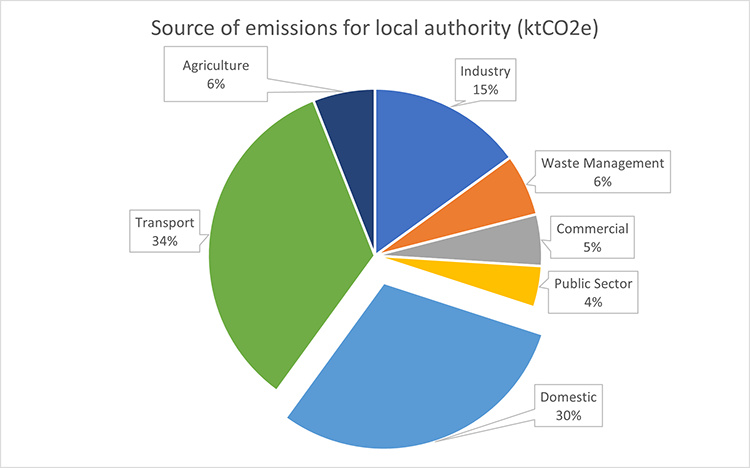This blog covers some of a County Council's experiences, thoughts, and tips from their early stages of trying to tackle retrofit at a county-wide level and develop an action plan for the whole county.
Introduction
Diagram 1
Anyone working on climate change for a local council will be familiar with their pie chart – a breakdown of emissions for their local area that looks something like this:
This pie chart occupies my thoughts every day and drives everything I do. Every day I think about reducing emissions from all of these areas to get my council one step (or one tonne) closer to Net Zero. We’ve made great progress and have really detailed actions in some of these areas, but the one piece of the pie that stubbornly sticks in my head is domestic emissions.
We know the answer is retrofit. We even know that retrofit solves more than just the climate challenge, with a multitude of benefits stretching to economic opportunity, financial resilience and health outcomes for our residents. What we don’t know is where to start in a field that (outside of social housing) we have had little direct experience in and that is filled with barriers and complexity.
This blog covers some of our experiences, thoughts, and tips from our early stages of trying to tackle retrofit at a county-wide level and develop an action plan for the whole county.
Understand your context
Nobody wants to be stuck in the past, but this process has required us to understand where we are coming from. We have a history of effective programmes to support our residents, particularly those eligible for grant funding schemes such as the Energy Company Obligation (ECO). We also have a lot of officers who have experience and knowledge to bring to the table. The difficulty at times is identifying who they are and when the right point is to get them involved. Some officers have also been burnt in the past with schemes that have been reliant on government funding which are then withdrawn and are looking for longer term solutions that are not so reliant on grants. This context must be kept in mind when designing priorities for a new action plan.
Find and use the right data and take a holistic view
There are so many sources of data, and so many concerns about the validity of data that comes from Energy Performance Certificates (EPCs) that it can feel like you need to be both a data specialist and a retrofit assessor/EPC assessor to even begin.
In the past we have been bogged down in understanding our local housing archetypes and stock, which is important, but this can lead you to lose sight of the whole retrofit life cycle. Understanding your housing stock is key to choosing the right solutions, but data about the economic opportunities of retrofit, and your current installer capacity is equally important to generate investment. The solutions you choose need to address all elements of retrofit, from creating demand to growing installer capacity to choosing the right solutions for your area.
Learn from those who have gone before
If there is one thing, we have taken from the LGA Local Retrofit Action Planning workshops, it is taking inspiration from those who have gone before. We now know that we do not need to be pioneers but can adopt and adapt solutions that have worked elsewhere to our local context.
The LRAP programme covered examples of areas who have built effective partnerships with Further Education colleges, who have directly engaged their local installer markets and who have used behavioural approaches and designed different solutions for different parts of their communities to bring everyone with them on the retrofit journey.
I will not pretend we have all the solutions but can say with some confidence that our early work on retrofit and participation in the LRAP programme has helped us see the wood for the trees, and identify our next steps for bringing down our emissions from domestic housing.
You can read all the technical briefings and watch the webinars we participated on the LGA website.

